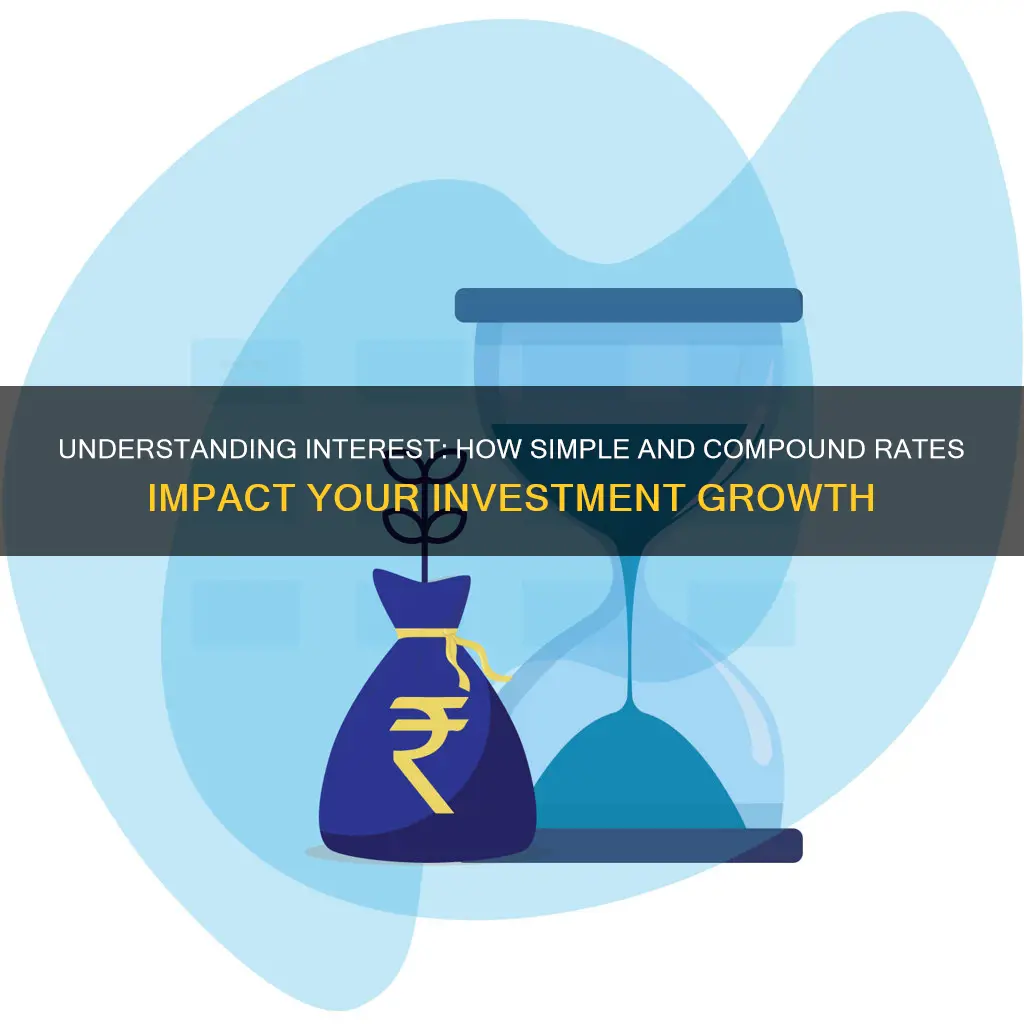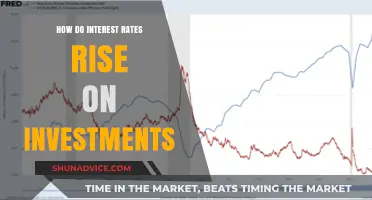
Understanding the impact of interest on investments is crucial for anyone looking to grow their money. Simple and compound interest are two fundamental concepts that can significantly influence the growth of your investments over time. Simple interest is a straightforward calculation, where interest is applied only to the initial principal amount, resulting in a linear increase. On the other hand, compound interest is more complex, as it involves earning interest on both the principal and the previously earned interest, leading to exponential growth. These interest mechanisms play a pivotal role in determining the final value of your investments, making them essential factors to consider when planning for the future.
What You'll Learn
- Simple Interest Basics: Understanding the formula and how it applies to short-term investments
- Compound Interest Power: How compounding grows returns over time for long-term investments
- Interest Rates Impact: How changes in interest rates affect investment returns
- Investment Strategies: Using interest to maximize returns through strategic investment choices
- Risk and Rewards: Balancing risk with potential gains in interest-bearing investments

Simple Interest Basics: Understanding the formula and how it applies to short-term investments
Simple interest is a fundamental concept in finance, offering a straightforward way to calculate the interest earned on investments over a specific period. This method is particularly useful for short-term investments, providing a clear understanding of the returns without the complexity of compound interest. The formula for simple interest is simple: I = P x R x T, where I represents the interest, P is the principal amount (the initial investment), R is the annual interest rate (expressed as a decimal), and T is the time in years. This formula is a direct calculation of the interest earned, making it easy to understand and predict.
In the context of short-term investments, simple interest is advantageous as it provides a clear and fixed return. For instance, if you invest $1000 at a simple interest rate of 5% for one year, the interest earned would be $50 (I = $1000 x 0.05 x 1). This calculation is straightforward and does not involve the compounding of interest, which can make long-term investments more complex. Short-term investors often prefer this simplicity, especially when comparing different investment options or assessing the potential returns on their capital.
Understanding the simple interest formula is crucial for investors as it allows them to quickly estimate the interest earned and, consequently, the total return on their investment. This is particularly useful when making quick decisions or when the investment period is relatively short. For example, a business owner might use this formula to calculate the interest on a short-term loan, helping them plan their cash flow more effectively.
The beauty of simple interest lies in its predictability. Once the principal, interest rate, and time are known, the interest earned can be calculated with certainty. This predictability is a significant advantage over compound interest, which can lead to varying returns due to the compounding effect over time. In short-term investments, where the focus is often on quick returns, simple interest provides a reliable and transparent method of calculation.
In summary, simple interest is a powerful tool for understanding the returns on short-term investments. Its straightforward formula and predictable nature make it an essential concept for investors to grasp. By mastering this concept, investors can make more informed decisions, especially when evaluating the potential of different investment opportunities that offer simple interest rates. This knowledge empowers investors to navigate the financial markets with greater confidence and clarity.
Interest Rates: The Key to Unlocking Investment Decisions
You may want to see also

Compound Interest Power: How compounding grows returns over time for long-term investments
The concept of compound interest is a powerful tool for investors, especially when it comes to long-term financial goals. It is a fundamental principle in finance that can significantly impact the growth of your investments over time. Here's an in-depth look at how compound interest works and why it's a game-changer for long-term wealth accumulation.
When you invest, you typically earn interest on your initial investment, and this interest can then earn interest in subsequent periods. This process is known as compounding. The key to understanding its power lies in the exponential growth it enables. With each passing period, the interest earned is added to the principal, and the subsequent interest is calculated on this larger sum. This creates a snowball effect, where your money grows faster and faster over time. For example, if you invest $10,000 at an annual interest rate of 5%, after the first year, you'll earn $500 in interest, bringing your total to $10,500. In the second year, you'll earn 5% interest on $10,500, resulting in $525 in interest. This pattern continues, and the cumulative effect is remarkable.
The longer your money compounds, the more significant the impact. This is particularly true for long-term investments, such as retirement accounts or long-term savings plans. Let's illustrate this with a hypothetical scenario. Imagine investing $5,000 at a 7% annual interest rate, compounded annually for 20 years. After the first year, your investment grows to $5,350. Fast forward to the 20th year, and your initial $5,000 investment will have grown to approximately $16,386. The power of compounding becomes evident when you compare this to simple interest, where the interest is calculated only on the initial principal.
The beauty of compound interest is its ability to accelerate wealth creation. It allows your money to work harder over time, generating returns that can significantly increase your net worth. This is why many financial advisors emphasize the importance of starting to invest early and letting compound interest do its magic. The longer your investment compounds, the more time it has to grow, and the greater the potential for substantial returns.
In summary, compound interest is a critical factor in long-term investment strategies. It transforms the way your money grows, turning a modest initial investment into a substantial sum over time. Understanding and harnessing the power of compounding can be a key step towards achieving financial goals and building a secure future.
Interest Rate Shifts: Impact on Investment Values and Mortgage Rates
You may want to see also

Interest Rates Impact: How changes in interest rates affect investment returns
Interest rates play a pivotal role in the world of investments, significantly influencing the returns generated by various financial instruments. When central banks adjust interest rates, it creates a ripple effect across the entire economy, impacting businesses, consumers, and investors alike. Understanding how these changes affect investment returns is crucial for anyone looking to navigate the complex landscape of personal finance and investment management.
One of the most direct ways interest rates impact investments is through the mechanism of simple interest. Simple interest is calculated as a percentage of the principal amount, and it remains constant throughout the investment period. For instance, if you invest $1,000 at a simple interest rate of 5%, you will earn $50 in interest annually, and the total amount at the end of the year will be $1,050. This straightforward calculation highlights how interest rates directly influence the growth of your investment.
However, the real power of interest rates comes into play with compound interest, which is more complex and often more advantageous. Compound interest is calculated not only on the initial principal but also on the accumulated interest from previous periods. This means that each year, you earn interest on the new total, which includes the original investment and the interest earned in the previous years. For example, if you invest $1,000 at an annual interest rate of 5% and this rate is compounded annually, the investment grows as follows: Year 1: $1,050, Year 2: $1,102.50, and so on. As you can see, the power of compounding becomes evident over time, leading to significantly higher returns compared to simple interest.
The impact of interest rate changes on investments is particularly notable in fixed-income securities such as bonds and fixed deposits. When interest rates rise, the value of existing bonds and fixed deposits tends to fall because new investments offer higher returns, making older, lower-yielding securities less attractive. Conversely, when interest rates fall, the value of these securities can increase as investors seek higher yields. This dynamic is crucial for investors to consider when managing their portfolios, especially those heavily reliant on fixed-income investments.
Moreover, interest rate changes can also influence the performance of stocks and mutual funds. During periods of rising interest rates, investors might shift their focus towards fixed-income securities, causing stock prices to decline. Conversely, when interest rates fall, the appeal of stocks may increase, potentially driving up their prices. This shift in investor sentiment can significantly impact the overall market and individual investment returns.
In summary, interest rates are a critical factor in investment decisions, affecting both the growth and the overall returns of various financial instruments. Understanding the difference between simple and compound interest and how interest rate changes influence investment values is essential for investors to make informed choices. By staying informed about monetary policy and market trends, investors can better navigate the ever-changing investment landscape and optimize their financial portfolios.
Interest Rates: The Key to Unlocking Future Investment and Spending
You may want to see also

Investment Strategies: Using interest to maximize returns through strategic investment choices
Understanding the concepts of simple and compound interest is crucial for investors looking to maximize their returns. These interest calculations can significantly impact the growth of your investments over time. Here's how you can utilize this knowledge to make strategic investment choices:
Simple Interest and Its Impact: Simple interest is a straightforward calculation where interest is applied only to the initial principal amount. It does not consider the interest earned in previous periods. For investments, simple interest can be beneficial in certain scenarios. For instance, when investing in short-term projects or bonds with fixed maturity dates, simple interest can provide a predictable return. This predictability allows investors to plan their cash flows effectively. However, it's important to note that simple interest may not offer the highest returns compared to compound interest, especially over longer investment periods.
Compound Interest: The Power of Compounding: Compound interest is a more powerful force that can significantly boost investment returns. This type of interest calculation adds the interest earned to the principal, and then interest is calculated on the new total. As a result, your investment grows exponentially. For example, if you invest $10,000 at an annual interest rate of 5%, the first year you earn $500 in interest. In the second year, you earn interest on the new total of $10,500, resulting in a higher return. Over time, compound interest can turn a modest investment into a substantial sum. This is why long-term investors often prefer investments that offer compound interest, such as stocks, real estate, or certain savings accounts.
Strategic Investment Choices: To maximize returns using interest, consider the following strategies:
- Long-Term Investments: Take advantage of compound interest by investing for the long term. The longer your money is invested, the more time it has to grow exponentially. Diversify your portfolio with assets that offer compound growth potential.
- High-Interest Accounts: Explore savings accounts, certificates of deposit (CDs), or money market accounts that offer competitive interest rates. These can provide a steady stream of income and potentially grow your principal over time.
- Reinvest Dividends: When investing in dividend-paying stocks, consider reinvesting the dividends to purchase additional shares. This strategy, known as dollar-cost averaging, allows you to benefit from compound interest on the reinvested dividends.
- Debt Management: Understand the difference between good and bad debt. While borrowing at low-interest rates can be beneficial for investments, high-interest debt should be managed carefully to avoid eating into your investment returns.
By incorporating these strategies, investors can harness the power of interest to their advantage. Simple interest can provide a solid foundation, while compound interest drives long-term growth. Strategic investment choices, combined with a solid understanding of interest calculations, can lead to significant financial gains. Remember, the key is to make informed decisions, diversify your portfolio, and stay committed to your investment goals.
Interest Rates: Unlocking Investment Potential or Hindrance?
You may want to see also

Risk and Rewards: Balancing risk with potential gains in interest-bearing investments
When considering interest-bearing investments, understanding the concepts of simple and compound interest is crucial for assessing the potential returns and risks involved. Both types of interest calculations have distinct impacts on the growth of your investment, and recognizing these differences can help investors make informed decisions.
Simple interest is a straightforward calculation where interest is applied only to the initial principal amount. It does not consider the accumulated interest from previous periods. For example, if you invest $1,000 at a simple interest rate of 5% for one year, you will earn $50 in interest, resulting in a total of $1,050 at the end of the year. This method is easy to calculate and understand, making it appealing for short-term investments or when comparing different investment options. However, it's important to note that simple interest may not provide substantial growth over time, especially in low-interest environments.
Compound interest, on the other hand, is a more complex and powerful force. It involves calculating interest on the initial principal and also on the accumulated interest from previous periods. This means that each period's interest is added to the principal, and the subsequent interest is calculated on this new total. For instance, using the same $1,000 investment at a 5% annual compound interest rate, after the first year, you would earn $50 in interest, bringing the total to $1,050. In the second year, the $50 of interest would also earn interest, resulting in an additional $2.50, and so on. Compound interest can significantly boost your returns over time, making it an attractive feature for long-term investments.
The key difference lies in the time value of money. Compound interest recognizes that money has a higher value when invested for a more extended period, as it has more time to grow. This concept is particularly relevant for retirement planning or long-term financial goals. While simple interest can provide a steady return, compound interest offers the potential for more substantial gains, especially in investments with higher interest rates or those held for extended periods.
However, it's essential to balance the potential rewards with the associated risks. Higher interest rates often indicate higher-risk investments, as they may be associated with more volatile markets or less stable financial instruments. Investors should carefully consider their risk tolerance and financial goals when deciding between simple and compound interest-bearing investments. Diversification and a long-term perspective can help manage risk while maximizing the benefits of compound interest.
Interest vs. Investment Earnings: Navigating the Tax Maze
You may want to see also
Frequently asked questions
Simple interest is calculated as a percentage of the principal amount, and it remains the same throughout the investment period. Compound interest, on the other hand, is calculated on the initial principal and the accumulated interest from previous periods, resulting in exponential growth over time.
With simple interest, the return is directly proportional to the principal. For example, if you invest $1000 at a simple interest rate of 5%, you will earn $50 in interest each year, and the total return will be $1050 after one year. This method is straightforward but may not yield significant returns over longer periods.
Compound interest allows investors to earn interest on the interest earned in previous periods. This means that the returns grow exponentially, leading to substantial gains over time. For instance, an investment of $1000 at an annual compound interest rate of 5% will grow to approximately $2,205.55 after 10 years, demonstrating the power of compounding.
Let's consider an investor who puts $5000 into a savings account with a 6% annual compound interest rate. After 20 years, the investment will grow to approximately $19,671.60. The power of compounding becomes evident when comparing this to simple interest calculations, where the final amount would be lower due to the lack of interest on accumulated interest.
Yes, investors can take advantage of compound interest by starting early and making regular contributions to their investments. The earlier you begin, the more time your money has to grow exponentially. Additionally, investing in assets with higher potential returns, such as stocks or mutual funds, can lead to substantial compound growth over the long term.







